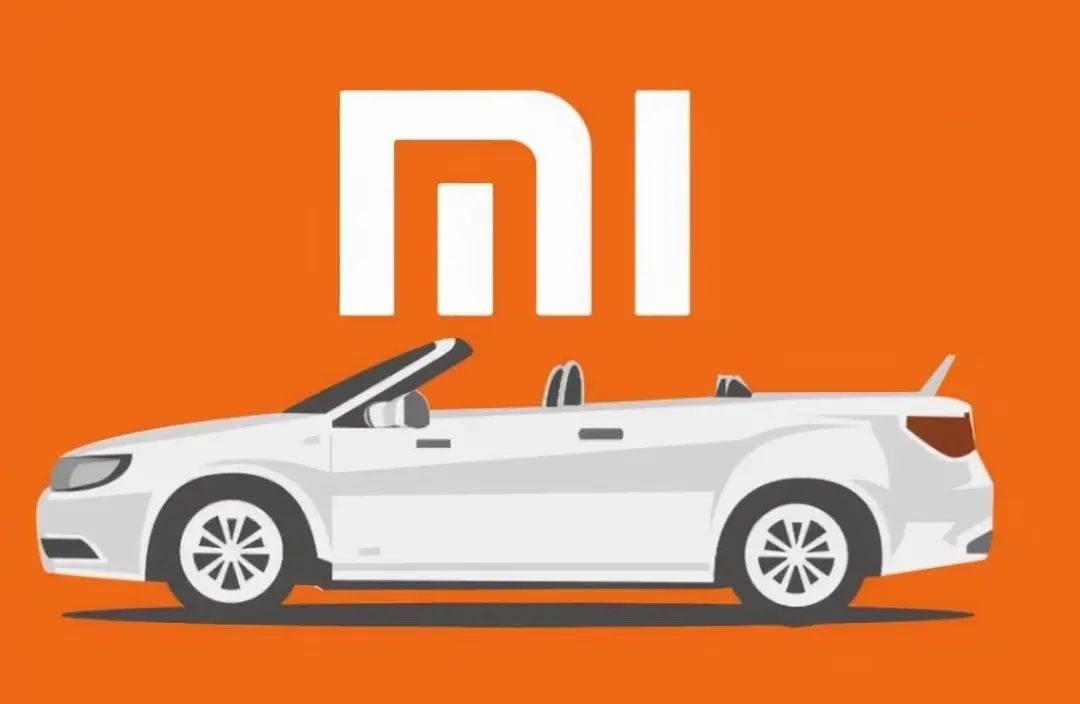Jia Haonan, sent from the co-pilot temple
Reference for intelligent vehicles | AI4Auto WeChat Official Account
First patent of Xiaomiauto is exposed!
It is unexpected. Lei Jun has repeatedly emphasized that the core competitiveness of Xiaomiauto lies in its intelligence ability. However, the first patent exposed by Xiaomiauto Technology Company, which was established after its founding, is electricity.
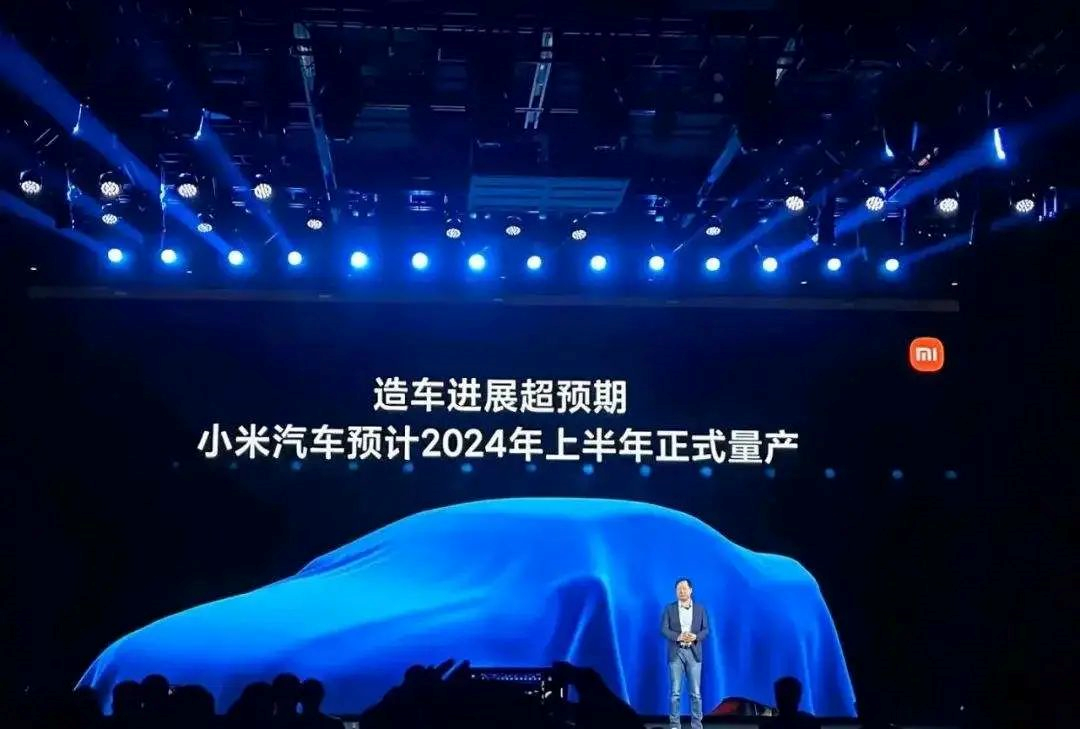
Since the establishment of Xiaomiauto, most of the news has been about people, money, and location. As for what the first car of Xiaomiauto will look like, it is still a mystery.
Therefore, this new progress is worth paying attention to.
What is the first patent of Xiaomiauto?
The first public patent of Xiaomiauto Technology Company is called “Method, Device and Readable Storage Medium for Controlling Multi-phase Motor.”
According to the introduction of the patent, the method includes:
In the case of phase fault of a multi-phase motor, acquiring the current position of the rotor, determining the target area to which it belongs, and controlling the multi-phase motor according to the control strategy corresponding to the target area.
Moreover, this patent can achieve the fault-tolerant control of the motor without increasing additional devices to change the hardware structure, thereby improving the reliability of the electric drive system.
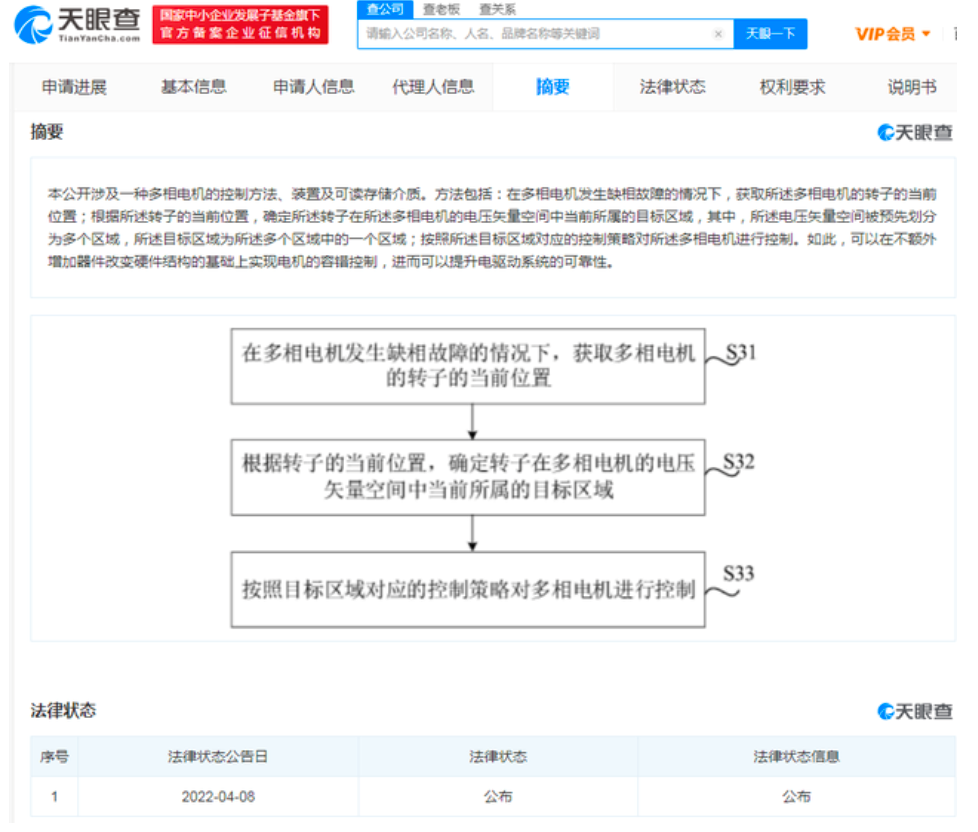
The specific meaning is to ensure the reliability of the electric drive system for electric vehicles.
Generally speaking, the driving motor of an electric vehicle mostly uses a permanent magnet multi-phase DC motor, which is more advantageous in terms of power and reliability than the three-phase motor on ordinary mechanical equipment.
Here, “phase” refers to the number of coil groups inside the motor.
The meaning of “phase fault” is similar to “cylinder missing” in traditional fuel vehicles, which means that one or several groups of coils experience a power interruption, resulting in a decrease in output power.
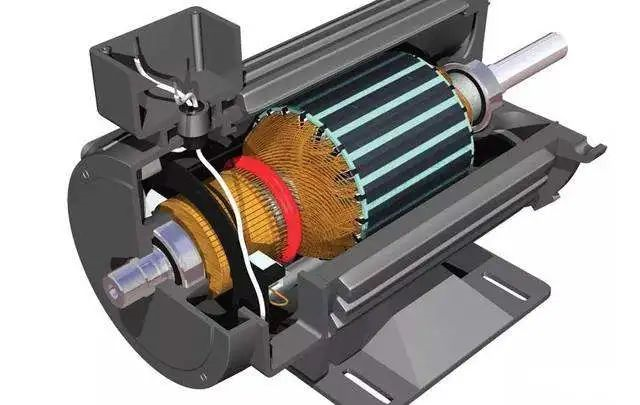
If the external load remains unchanged, the driver will feel a decrease in power and may step on the accelerator pedal more deeply, which may cause the current of the stator winding to suddenly increase much more than the normal value, and there is a risk of burning the motor.
As for the cause of “phase fault,” it may be poor contact, or it may be a misjudgment of the insurance by the electronic control system.
Although Xiaomiauto’s patent does not explicitly explain the method to deal with phase fault, it can be inferred from the description that it adjusts the energy input dynamically based on the angle of the motor rotor, according to its rotation position, so as to prevent overheating.
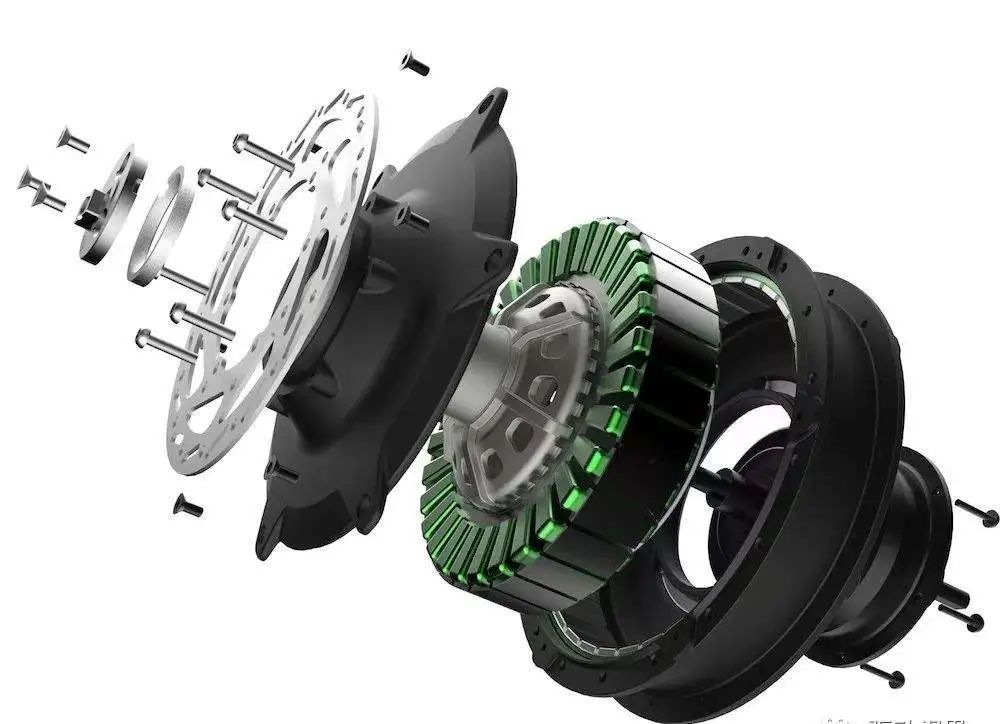 Well, Xiaomi’s first patent, which is by no means stunning, is indeed focused on safety.
Well, Xiaomi’s first patent, which is by no means stunning, is indeed focused on safety.
There are still many patent clues to be explored about what kind of product Xiaomi’s car will be.
What step has Xiaomi taken in car-making based on its patents?
This patent is called the first because it is the first patent revealed by Xiaomi Automobile Technology Co., Ltd. after its establishment.
Before that, Xiaomi Group had actually made a lot of preparations for car-making.
According to IP SAAS service provider Zhihuiya’s evaluation, as of the first quarter of 2021, Xiaomi Group’s patent value in the entire automotive field exceeded $100 million.
By comparison, Tesla’s patent value exceeds $200 million.
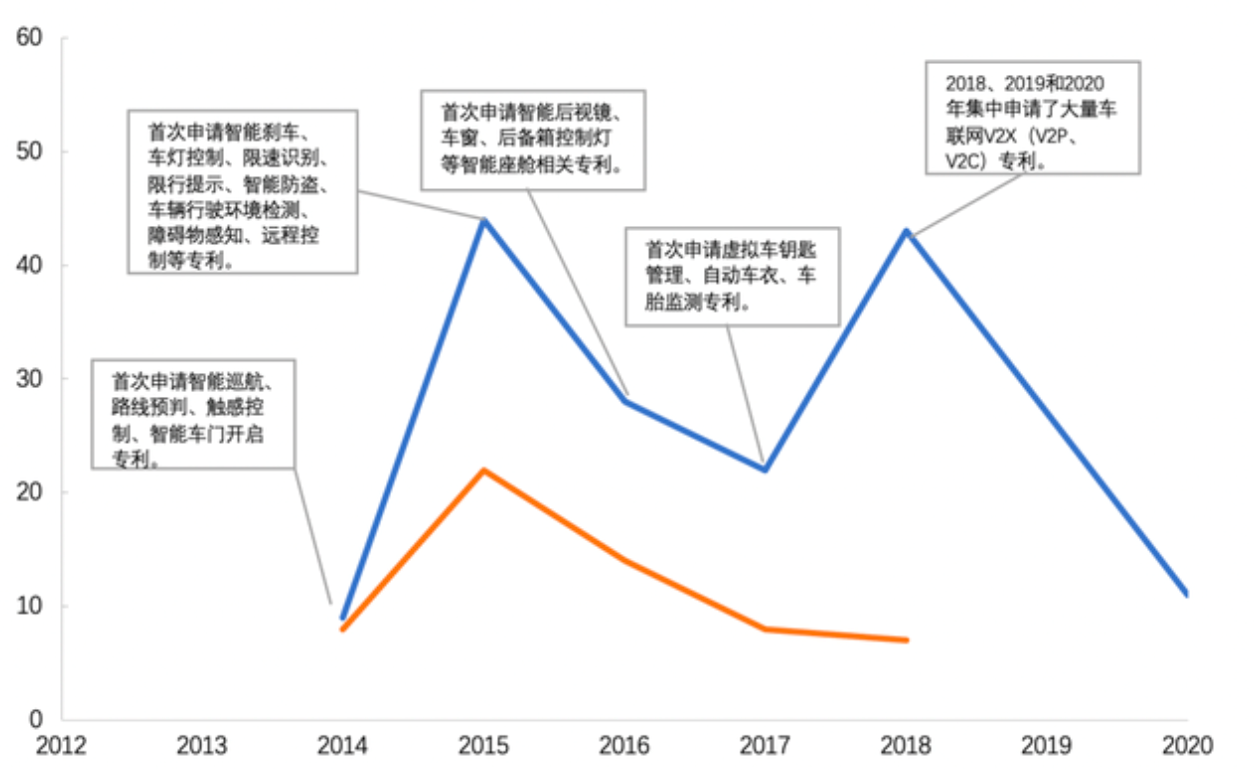
Xiaomi’s car-related patents with a total value of $100 million exceed 800 pieces, mainly concentrated in wireless communication networks, data processing, digital information transmission, image communication, traffic control systems, distance measurement, navigation, and other fields.
It can be seen that most of the car-related patents that Xiaomi has currently obtained are related to autonomous driving, intelligent cockpit, and vehicle networking.
For example, a few days ago, Xiaomi Mobile Software Co., Ltd. obtained vehicle-related patent authorization, including the vehicle body and the first camera module. The vehicle can collect target direction image information through at least two first cameras with different viewing angles, which can improve the clarity and accuracy of image information.
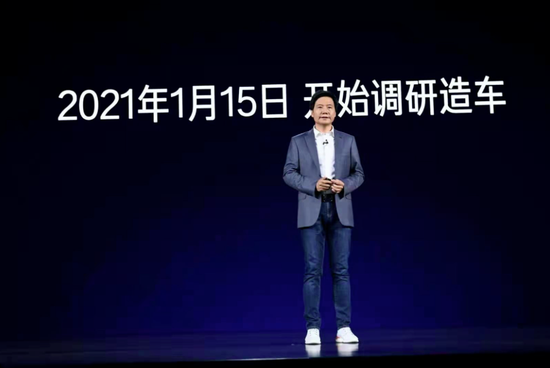
From the description, this is a pure visual autonomous driving scheme adapted to the entire vehicle.
In the field of intelligent cockpit, the patents applied for by Xiaomi include gesture control, intelligent anti-theft, intelligent vehicle door opening, in-vehicle environment monitoring, vehicle automatic adjustment, and automatic adjustment of vehicle lights for 15 scenarios, realizing automatic adjustment of in-vehicle equipment and vehicle safety warning through biometric recognition, sensors, and intelligent terminals.
For example, automatic window adjustment: adjust the vehicle’s window glass according to the outside noise value to prevent the outside noise from entering the vehicle and causing noise increase inside the vehicle.
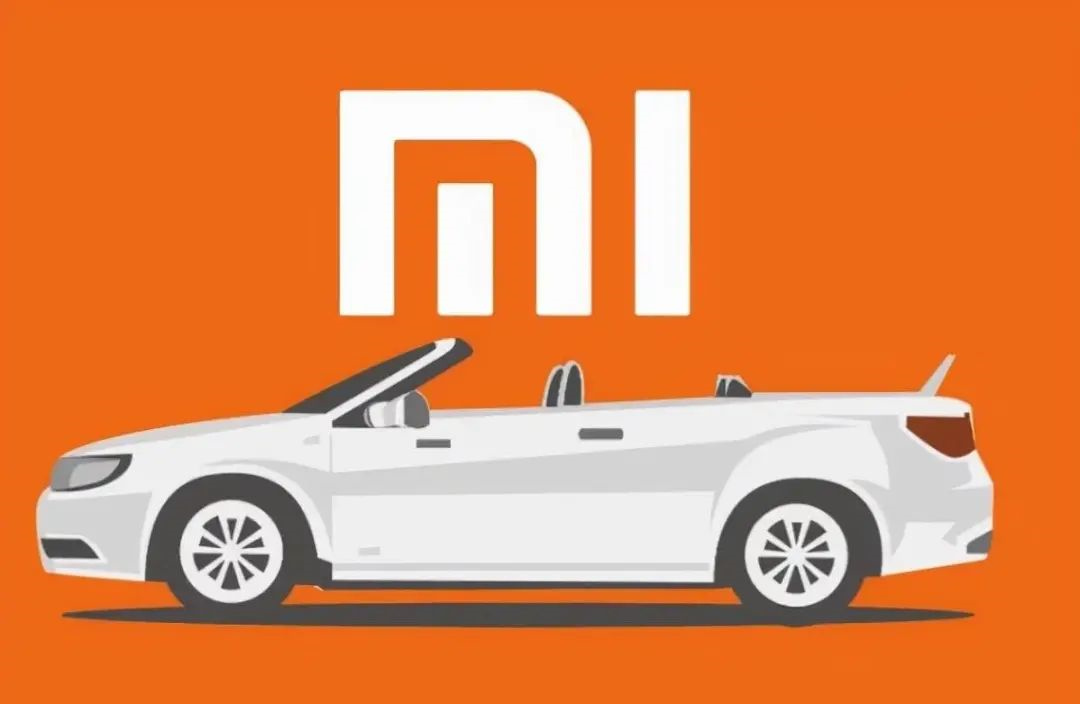
From the distribution of these patents, it is not difficult to find that Xiaomi’s car-making mainly focuses on software development, and has not yet gone deep into the structural design of the whole vehicle.
Xiaomi’s first motor-related patent disclosed by Xiaomi Automobile can be said to be the first patent related to “vehicles” in Xiaomi Automobile.
Therefore, it is reasonable to infer that Lei Jun’s previous estimation of Xiaomi’s car mass production in 2025.
Brainstorming: What will Xiaomi’s car be like?Finally, let’s brainstorm what the first production car of Xiaomi will look like.
One possibility is to focus on intelligence, like Tesla, XPeng, and Jidu Automobile, and turn the car into a trendy technology product.
Such a product positioning undoubtedly requires Xiaomi to have strong R&D capabilities in intelligence.
Intelligent cockpit, operating system, Xiaomi has no problem. With many years of accumulation of MIUI and Xiao AI, Xiaomi is ready to go.
Yejun Ye, who was previously in charge of Xiao AI, is now also a member of the Xiaomi Automotive team and is said to be the overall person in charge of intelligence.
As for autonomous driving, Xiaomi acquired start-up DeepMotion last year to solve the talent team problem at once.
However, compared to other leading companies in the unmanned vehicle race, DeepMotion’s aura is not prominent, and there is no production project to prove its strength. Its capabilities need to be verified.
In addition, if Xiaomi’s car wants to focus on intelligence, cost issues must be considered: Will intelligent driving be standard or optional?
If it is standard, the R&D cost will be shared in the car price. Under the same positioning of cars, will consumers be willing to pay a few thousand more?
If it is an add-on option, how many people will choose it? If the selection rate is as low as 1-2% like Tesla users in China, the future iteration and R&D of Xiaomi’s autonomous driving may not be optimistic, and the “smart car” pursued by Lei Jun will suffer a lot of discount.
Anyway, these are the decisions Lei Jun has to make.
Another way is to follow Xiaomi’s mobile phone strategy and be affordable for young people as their first car.
How can Xiaomi Automotive make money under the conditions of affordability and intelligent experience?
As you may already guessed: the ecosystem.
Like Xiaomi mobile phones, the product itself has low profit margins, and the main revenue comes from ecosystem platform services and advertising fees.
But, can you accept the experience of watching an advertisement before starting the car?
The last possibility is to directly make Xiaomi cars into luxury cars that impact the high-end market.
In fact, this has been Lei Jun’s long-cherished wish for many years.
Automobiles are a completely new starting line, and Xiaomi has relatively few historical burdens, so it can try.And during the live broadcast of Lei Jun, the majority of Mi fans hoped that Xiaomi would make mid-to-high-end car models.
When Lei Jun announced the car-making plan, he also said he would “bet his entire reputation” on it, making it hard to believe that he would repeat the same path as Xiaomi’s smartphones.
However, in the poll on Weibo, the general public’s expectation for Xiaomi’s cars is still for cost-effective products:
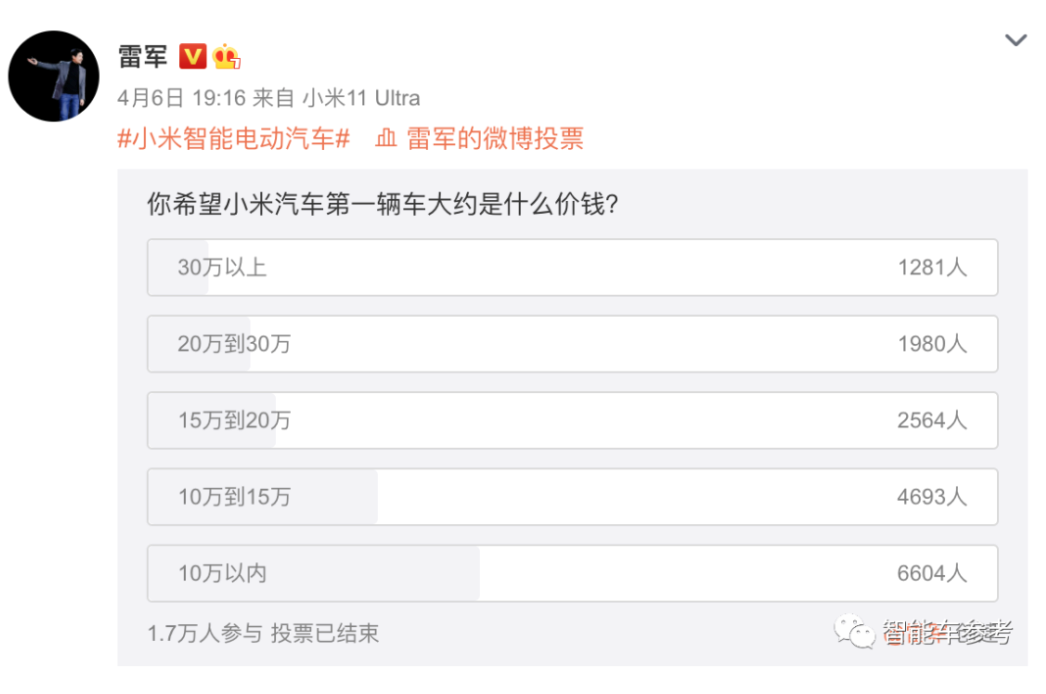
Intelligence, cost-effectiveness, and high-end, which kind of Xiaomi car do you think will be more promising?
— The End —
This article is a translation by ChatGPT of a Chinese report from 42HOW. If you have any questions about it, please email bd@42how.com.
